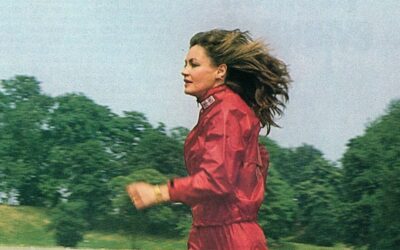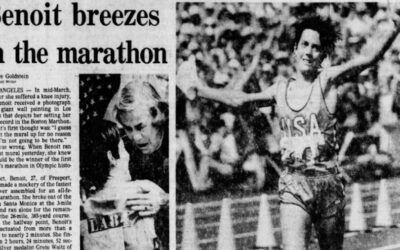Imagine a time when women did not run in road races. Imagine a time when women were told distance running would harm their health. Imagine a time when running in a marathon meant risking being jeered at or even assaulted.
This time was in my lifetime. I was born in 1963. Women in the UK were not permitted to compete in road races longer than 6 kilometres until late 1975. I was 21 by the time the women’s marathon made it on to the Olympics programme at Los Angeles 1984.
When I was one year old, a Scottish woman called Dale Greig broke the rules and ran a marathon.
Greig’s marathon run marks a milestone in women’s marathon history in the UK and worldwide. She was the first woman to run a marathon in under three and a half hours. Her time was retrospectively recognised by World Athletics as a world best time. The next British woman to feature in the world marathon progression table is Paula Radcliffe 38 years later, running 2:17:18 at the 2002 Chicago Marathon.
Dale Greig and the Isle of Wight Marathon 1964
Dale Greig travelled from Paisley to the Isle of Wight to take part in the marathon, held on 23rd May 1964. The brother of her business partner, the publisher and printer Walter Ross, lived on the island and was a member of Ryde Harriers, the organisers of the race. Greig had been on holiday to the Isle of Wight before and had helped out at the marathon. She had run some of the route with Walter Ross and his brother Bill. It probably wasn’t too difficult to persuade the running club to allow her to run the marathon as a time trial.
In order to run the route as a time trial, Greig had to start four minutes ahead of the men. This meant the organisers could argue that they had not broken the Amateur Athletics Association rules which did not permit men and women to race together.
Dale Greig pictured at Ryde on the Isle of Wight, probably on the morning of the race.
Of the 67 men who started the race, 19 failed to finish. Greig finished strongly catching up with several men. She crossed the line in 3 hours 27 minutes and 25 seconds (later incorrectly recorded as 45 seconds), a new world best time.
Womens’ world marathon progression – 1960s
Violet Piercy (GB) – 1926
Violet Piercy (b. 1889?), is recorded as having run a marathon distance in 3:40:22 on 3rd October 1926. Peter Lovesey, in his entry on Piercy in the Oxford Dictionary of National Biography, notes that there is some doubt over the exact length of the run, as it was not part of a race and it may have been a shorter distance. Piercy ran from Windsor to London.
It was widely assumed at the time and until recently that she ran over the course set for the 1908 Olympic Games, from which the distance of 26 miles 385 yards or 42.195 km was established. However, she appears to have taken a more direct route along the Bath Road, passing Hounslow and finishing at Battersea Town Hall. The only substantial report so far discovered (Westminster Gazette, 4 Oct 1926) wrote of her covering ‘just over 20 miles’. Whatever the truth about the length of the run it was still a pioneering feat.
Lovesey reports that Piercy made other solo attempts at the marathon distance and in 1936, the organisers of the Polytechnic Marathon, Britain’s most celebrated marathon, permitted her to run, starting ahead of the men. She completed the accurately measured distance in 4 hours 25 minutes.
Merry Lepper (USA) – Western Hemisphere Marathon, December 1963
Merry Lepper (b. 1942) was 20 years old and living in California when she and her training partner Lyn Carman (1936-2014) decided to “crash” the Western Hemisphere Marathon in Culver City.
Lepper recounts that she and Carman hid behind an oleander hedge and joined the men just after the start. During the race they endured heckling from spectators and an official accosted Carman at one point. Carman dropped out at around 20 miles, but Lepper went onto finish. A sympathetic race official recorded her time of 3:37:07 and it was subsequently recognised by World Athletics as a women’s world best performance.
Lepper was the first woman in the USA to complete an organised road marathon. Writing in 2017, she said:
Distance running gave me confidence that affected so many areas of my life, especially my career…. More than anything else, running taught me to not be afraid to attempt what society says is impossible. It taught me how to prove my doubters wrong so they wouldn’t think less of women. AAU rules have changed for the better, and I’d like to think I’ve played a role in that.
Dale Greig (GB) – May 1964
Dale Greig’s time of 3:27:45 was all the more impressive because the Isle of Wight Marathon course was a tough one with 1505ft of ascent.
Greig’s participation in the marathon was picked up by the local and national press and aroused considerable interest, most of which was positive. The Daily Mirror (25th May 1964) was not in favour of the women’s marathon:
Talking Point. Should women be encouraged to run the marathon course of 26 miles 365 yards? Dale Greig, a 27-year-old Scottish secretary from Paisley, covered that distance on Saturday in 3h 27m 45s and aims to challenge an American girl who, 3 months ago, did it in 3h 35m. The idea does not intrigue us. Forget it Dale!
It is very likely that Greig would have been aware of Merry Lepper’s record set six months before. The Daily Herald also reported that she was going to challenge Lepper to a race. However, Greig, no doubt incensed by the tone of the Daily Mirror’s piece, sent the paper a letter denying that this was the case.
Greig represented Scotland at the International Cross Country Championships in England in 1968. She had also competed at an unofficial international women’s championships held in Scotland in 1957.
She set other firsts for women in the 1970s, including the 40-mile Isle of Man race and the London to Brighton 53-mile race which she took part in unofficially. In 1974, she became world champion in the inaugural IGAL Masters Marathon Championships in Paris
Mildred Sampson (NZ) – July 1964
Mildred Sampson (b. 1933) was a member of Owairaka Amateur Athletics Club in Auckland. Founded in 1943 as an athletics club for boys and girls, the club also had both men and women as members. It began to organise marathons in 1962. The men Sampson trained with encouraged her to have a go at the marathon distance. In a 2008 interview, Sampson recalls training hard for the race, running twice a day, before and after work.
It appears this was not an open race, but a time trial organised by the club. World Athletics records the date as 21st July 1964, although other sources suggest it took place on 16th August. Sampson’s time was 3:19:33. In 1970, she ran another marathon in Auckland in 3:13:58.
Sampson was the national cross country champion in 1966, 1968 and 1972. She also won three unofficial titles in the event from 1963-65. She represented New Zealand at the International Cross Country Championships twice: in Scotland in 1969, finishing seventh out of 40 finishers, her best placing in an international event, and in Spain in 1971. In 1973, she competed in the first IAAF World Cross Country Championships in Belgium.
Maureen Wilton (CAN) – May 1967
Remarkably, Maureen “Moe” Wilton (b. 1953) was just thirteen years old when she ran a world best marathon time of 3:15:22 at York University Marathon in Toronto, Ontario on 6th May 1967. She was coached by Thian Sy Mah at the North York Track Club.
Mah was an early proponent and promoter of marathon running. The race was his first marathon and he went on to run over 500 marathons. Mah was unusual in that he did much to support and advance women’s distance running, recognising and nurturing exceptional talent and refusing to put limits on what women could achieve. Eleven years later, when he was teaching at the University of Toledo, Mah coached and mentored one of his students, Lorna Richey (now Richey Michael), to become a marathon runner and then an ultrarunner. Richey would go on to set American records at the New York 6 Day Race in both 1983 and 1984.
Mah ran the first three laps of the five-lap course with Wilton. Other members of the club ran with her for the last two laps.
In 1969 at the age of fifteen, Wilton represented Canada at the International Cross Country Championships in Scotland, competing against Mildred Sampson. Wilton, who may have been the youngest in the race, finished thirty-first out of 40 finishers.
Wilton (now Mancuso) lost interest in running as her friends left the track club. She stopped running altogether at seventeen.
Anni Pede (FRG) – September 1967
Anni Pede (b. 1940) was twenty-seven years old when, along with nineteen-year-old Monika Boers, she was invited to take part in a marathon race.
At fifteen Anni Erdkamp joined OSC Waldniel, an athletics club founded in 1953 by Dr Ernst van Aaken (1910-1984) and eleven other athletes. Waldniel is in North Rhine Westphalia and was then in the Federal Republic of Germany. Her talent was immediately obvious to van Aaken who reported in his book “Programmiert fuer 100 Lebensjahre” (Programmed to Live to 100) that the first time she appeared at training Erdkamp ran 3000m in 13 minutes.
Contrary to the prevailing views at the time, van Aaken, a medical doctor, believed that children and women were natural endurance runners and that the focus on sprint distances and interval training did not use their natural abilities. He challenged the idea that women were the weaker sex, arguing that this was only the case when muscular strength was assessed. Women, he said, were superior to men as endurance athletes in many fields, such as distance running and swimming, because of their physical and mental make-up.
Van Aaken was aware of Maureen Wilton’s record time, and wanted to show that it was perfectly possible for children and women to perform well at the marathon distance. He comments that even though she had had a four-year break from athletics during which she had given birth to two children, Pede was able to run a time of 3:07:26 at her first attempt: “a performance which even good male 10km runners fail to achieve at their first attempt” (my translation).
The German Athletics Association did not permit women to run marathons, but officials agreed to allow Pede and Boers, who was also a member of OSC Waldniel, to start 30 metres behind the men. Pede finished third and Boers finished in 3:19:36.
Waldniel has been called the cradle of the women’s marathon as it was there that in 1973 van Aaken organised the first women’s marathon.
In conclusion
The 1960s marked the first quickening of a desire for women to be allowed to participate in the marathon and other road races. In the 1970s, this desire, this demand, grew into organised campaigns, but the seeds were sown in the 1960s when women in several countries began to break the rules and compete in men-only races.
In 2019, thousands of women around the world completed marathons. There were 17,782 female finishers at the London Marathon alone. Today it is easy for all of us to take for granted what was a hard-won right for women to compete in the marathon and other road races. We owe a lot to women like Dale Greig.
Related articles
“There’ll be no prizes for women” – a much longer article about Dale Greig appears in Issue 25 of Like the Wind magazine.
“Milestones in Women’s Marathon History – 1964 – Dale Greig“, Playing Pasts website, May 2020
Road Running in the UK in the 1950s
Hey, women can do anything – an article about Kathrine Switzer
Jacqueline Hansen and the women’s marathon revolution
The first London Marathon – the story of the Avon International Women’s Marathon
“I was a little bit before my time” – pioneering marathon runner Joyce Smith
Sources
ARRS (Association of Road Racing Statisticians) – marathon results and women’s marathon performances in 1960s
IAAF (now World Athletics) World Record Progression, 2011.
International Cross Country Championships results and IAAF World Cross Country Championships results – Wikipedia
British Newspaper Archive
Violet Piercy by Peter Lovesey, Oxford Dictionary of National Biography, 30th May 2013
The Forgotten First Lady: Rediscovering Violet Piercy, Marathon Pioneer by Peter Lovesey, Playing Pasts website, 28th December 2020 (three part article)
“26.2 miles in My Shoes” by Merry Lepper, The Players Tribune website, 3rd November 2017
“Proud history in athletics”, Owairaka Athletics website
“Athletics: trailblazer of women’s distance running” by Eugene Bingham, The New Zealand Herald, 9th February 2008
“The Pioneer” by Mark Sutcliffe, irun.ca website (archived), November 2009
Club history, OSC Waldniel website
“Programmiert fuer 100 Lebensjahre” (Programmed to Live to 100), Dr.med.van Aaken, 1974, Pohl-Verlag, Celle
“Die Wiege des Frauen-Marathons stand in Waldniel” (Waldniel was the cradle of the women’s marathon), by Gustav Schroeder, German Athletics Association website, 9th November 2003




0 Comments